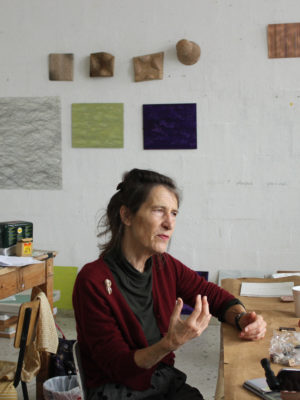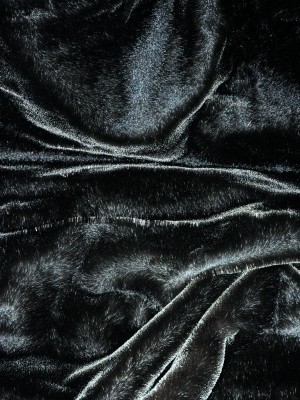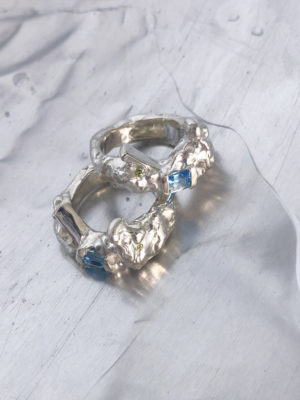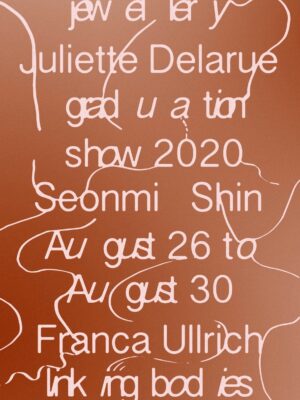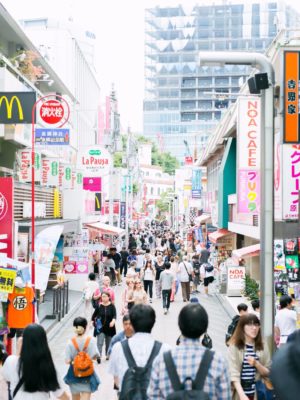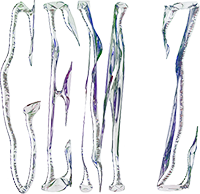Rebecca Schena
Could tell me about the exhibition, A Time of Seeing? What pieces will be shown?
Beppe Kessler
The basis of the exhibition is that I wanted to show the intimate relationship between one work and another. It is 40 years of work, so I picked out crucial pieces that show my development over time.
It will begin with a few early pieces of embroidery on paper and some small drawings, because they have a connection to my later embroidery pieces in wood. After those pieces are some of my pin pieces from about 10 years later, which are made from sewing pins and stuffed, hand-shaped canvases. Textile related examples from around this period, including a woven rubber bracelet from 1981− the first jewellery I ever made − will also be included in the exhibition. This bracelet led to a period of textile jewellery design, which is how I came into the world of jewellery: more or less by accident. It was the 80s, and that was the time of the democratisation of jewellery. You could work with materials from everyday life and not silver and gold, which was perfect for me because I came from the textiles department. When you work in textiles, it doesn’t mean that you are working only with textiles, but it means that you have a sensitivity for materials. I think that’s more crucial than the preciousness of a material.
Once I started working with jewellery, I decided to combine my interest in textiles, jewellery and painting, and make painted textile brooches. One example is a brooch made from a piece of wood stretched with painted cotton. It was all about showing and not showing, so I think of them as ‘hide-and-seek’ brooches. For me, you don’t need to show everything that is happening inside of a piece, so something is happening under the textile: there is a hidden comic figurine of Bobbie and Tintin.
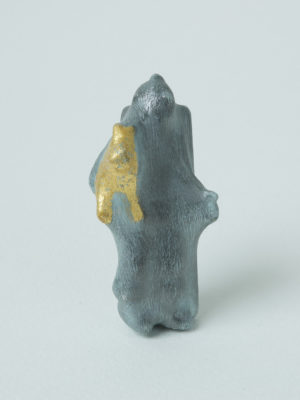
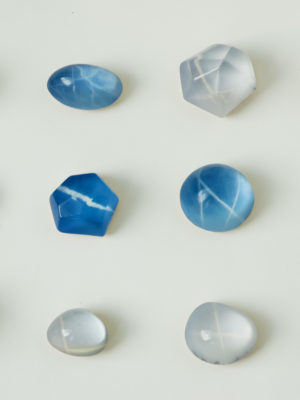
Maybe it is because I come from a textiles background, but each of my painted brooches, paintings and large embroideries start with stretching linen over frames that I sculpt myself, with curves and bulges that force the linen to curve in interesting ways. There was a period in the 2000s where I started to work with bigger canvases, but there is a limit to the size of the canvases because at a certain point, I cannot stretch the canvases with any more strength. So, when I say that I began to work ‘bigger’, for me that is not any larger than the human scale. It may be seen as a limitation, but I like to work on pieces that I can handle by myself.
It was during this period of time, around 2000, that I decided I was done with industrial textile design, which had − in combination with painting and jewellery − been my career for years until that point. Instead, I decided that it was enough for me to focus on painting and jewellery alone. My pieces began to focus on time: whether I worked on a piece for a day or a month wasn’t important. What was important was when I decided that a piece was done.
I worked for quite a long time with paintings and embroidery during this period − and have come back to paint again in my recent work − but then I jumped to all kinds of different materials: balsa wood, stone, amber, aluminium, bone. There is a piece called Touch (2005) that will be in the exhibition that includes hand-carved elements made from all of these materials. Maybe it is not the most beautiful piece, but it is like a charm necklace of my materials and it was a crucial step in my development. It served as a statement: ‘these are all my materials, I am interested in all materials.’
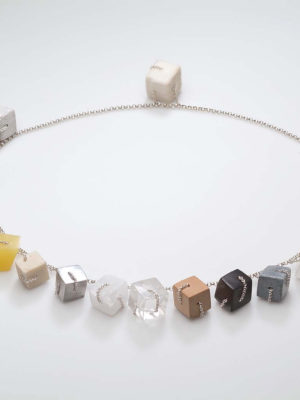
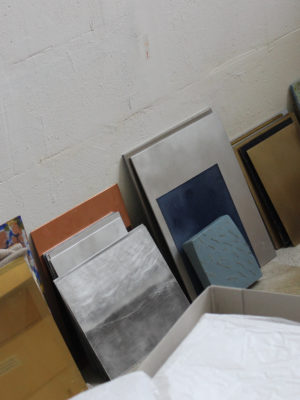
I read that your exhibition title, Een Tijd van Zien, translated to English as ‘A Time of Seeing,’ is a phrase from a poem by the Dutch poet K. Schippers. Can you tell me about this poem of his which is featured in the exhibition? How does it relate to your work?
K. Schippers, yes. He is a rather famous writer who was the Stadsdichter: the poet of the city of Amsterdam. I like his poems so much because they are about seeing and looking, and at the same time about nothing. They are about noticing very, very, small things. I felt that he was doing with words what I do in my work with material, so I just called him out of the blue and asked if he would like to write something for me. He was hesitant, but I invited him to come visit my studio and he agreed to come. I am so glad he did, because when he came into the studio, I saw it happening! He immediately understood that our work was parallel and agreed to write something. It’s amazing how he looks at words − sometimes he’s only looking at the white spaces in-between the words and he has written a beautiful poem about the white spaces. He is very inspiring and now we are good friends.
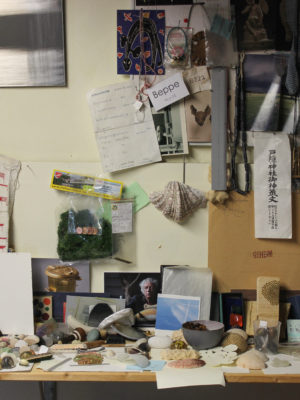
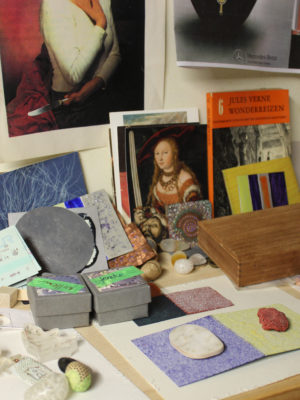
Is the poem in the exhibition based off of your work?
No, not technically. He said, ‘I will write a poem, but it’s not about you.’ It is parallel to my work, but it is not about my work. When I read it, I know what was happening in the studio when he visited, so I recognise my work in it, but he went completely his own way when writing it. His poem will be hanging on the wall of the exhibition, which I think is perfect because we have a parallel way of seeing things.
At the same time as the exhibition, I will be launching A Time of Seeing, 366 Works/Days, a calendar book that I created with an introductory text by Suzanne van Leeuwen of the Rijksmuseum. It includes an embroidered signature on the cover and piece of my work for every day of the year, which connect not only to the specific day they represent (for example, a piece with a hammer for Labor Day, a heart on Valentine’s Day and a piece with the colours of the Dutch flag to commemorate the end of WWII) but also make connections with each other.
In the exhibition, I think you have to take time to really see my work. With every piece of jewellery there is always another piece, usually a painting, that connects to it. I didn’t pair the pieces together and point out that this matches that because I want to push people to find the connections themselves. For example, there is a film in the exhibition that shows me working on pieces of drilled alabaster. There is also a small drilled painting that will be exhibited and people have to be clever to see the connection between these two pieces.
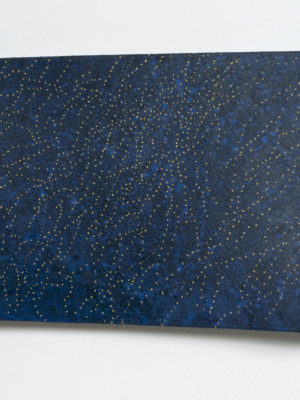
Could you provide some insight into your emotional process – what you’re thinking about and what you’re feeling – when you’re making work? How do you choose where to drill the holes in the alabaster or in your drilled paintings?
I feel a mixture of different things. I often feel curious − considering all of the different ways that I could make a piece and trying to decide what I should do next. Sometimes I’m bored, or frustrated, or upset that I spoilt a piece because it came out differently from how I had imagined it. But then this ‘spoiling’ will lead to the next step. It’s all based on intuition. The hands and eyes are more intelligent than the brain, so I always start with feeling the material and with doing instead of thinking. Then, when I’m doing, and touching, and feeling; then the thoughts come. I’m rather chaotic when working, I usually work on five or six things at once − some are really rubbish and some aren’t.
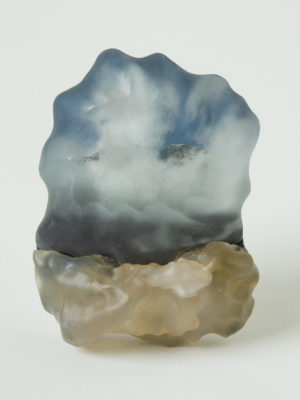
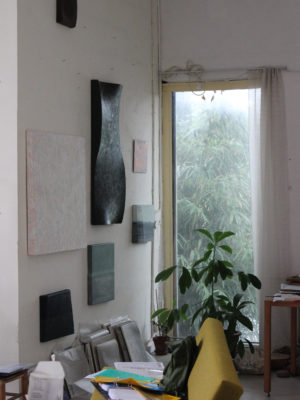
You talked earlier about your textile training and how you started your career in industrial textiles. I’m wondering if you see everything you make through a textile lens? I feel like there’s so much patterning and layering, and the way you make things is very methodical, like weaving.
I think that rhythm, repetition and colour are very important and I have a good intuition for those things, which definitely comes from my textiles training. In the textiles department I was a naughty girl because I didn’t want to weave. I didn’t want to weave because with weaving you have to plan before you make something: you plan and then you do.
Once I had started making jewellery, I had a gallerist say to me, ‘Your form language is so strong! If you use gold instead of brass it will sell.’ I tried! I made one brooch in gold and it sold immediately, but it’s not my cup of tea. For me it’s important to surprise myself, to find new ways of doing things and not to worry about making something exactly right so I don’t spoil the material. You can be a good textile designer, or have great technical skill in enamel, but it’s so different to be a good artist.
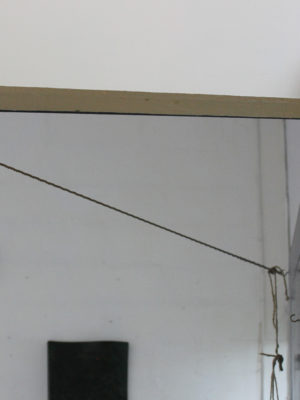
How does it feel to have such a wide variety of your work all shown together? When you’re thinking of this as a single exhibition space, how does it feel to look back on so many years of work all shown as one collection?
In the beginning it was a struggle to think of it all together as a retrospective. I am always eager to explore further, not look back on what I have done. But I must say that it brought me a lot of knowledge to see things that I did very early on. What is most interesting is what I didn’t do! I often wonder why I stopped a series of work at a particular moment instead of going further with it. In thinking about my work together I have been able to see a ‘red thread’ throughout my life; everything is interconnected even though it is not repeated. I’m very grateful that CODA asked me to do this.
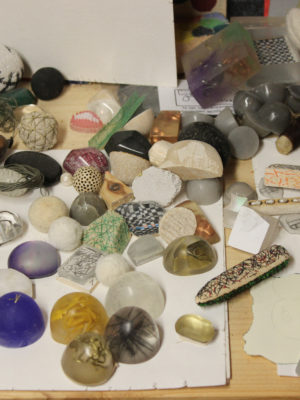
Where are you headed next? What kind of work are you thinking of doing in the future after this exhibition?
I’m looking forward to being free again and having more time for painting. There is a balance between jewellery and painting in my work, and this exhibition was a lot about jewellery, so I’m going to turn back the balance. It’s going to be nice to work without results, without a deadline and without it needing to be finished. To make rubbish again: that’s the beginning of new things.
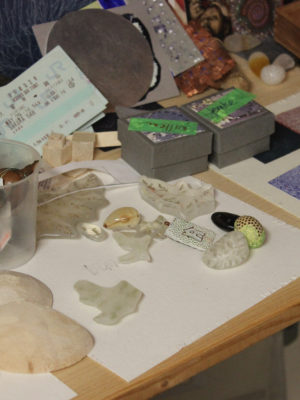
Photography in the studio by Neeltje van der Vlugt
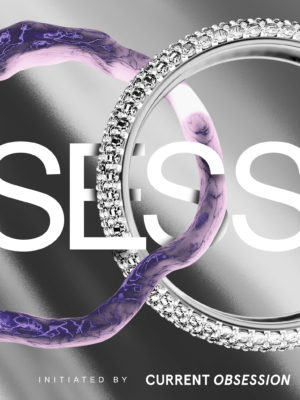
This article is published
in the OBSESSED! Jewellery Festival Paper.
OBSESSED! is a biennial jewellery festival taking place in various cities across the Netherlands. OBSESSED! unites the best jewellery-related events – museum and gallery exhibitions, talks, fairs, book presentations and artist open studios – into one intriguing programme put together by Current Obsession.
Een tijd van zien / A time of seeing
03–11–2019 until 01–03–2020
Opening 3 November
CODA Museum
Vosselmanstraat 299
7311 CL, Apeldoorn
www.coda-apeldoorn.nl
The museum is closed on 25 December, 1 January and 27 April
Monday Closed
Tuesday 10:00–17:30
Wednesday 10:00–17:30
Thursday 10:00–17:30
Friday 10:00–17:30
Saturday 10:00–17:00
Sunday 13:00–17:00
www.obsessedwithjewellery.com/event/een-tijd-van-zien-a-time-of-seeing/
